This post may contain affiliate links. Please read our disclosure policy.
This creamy green pea soup is quick, easy, and delicious! You’ll love the fresh taste of spring and the convenience of using frozen vegetables.
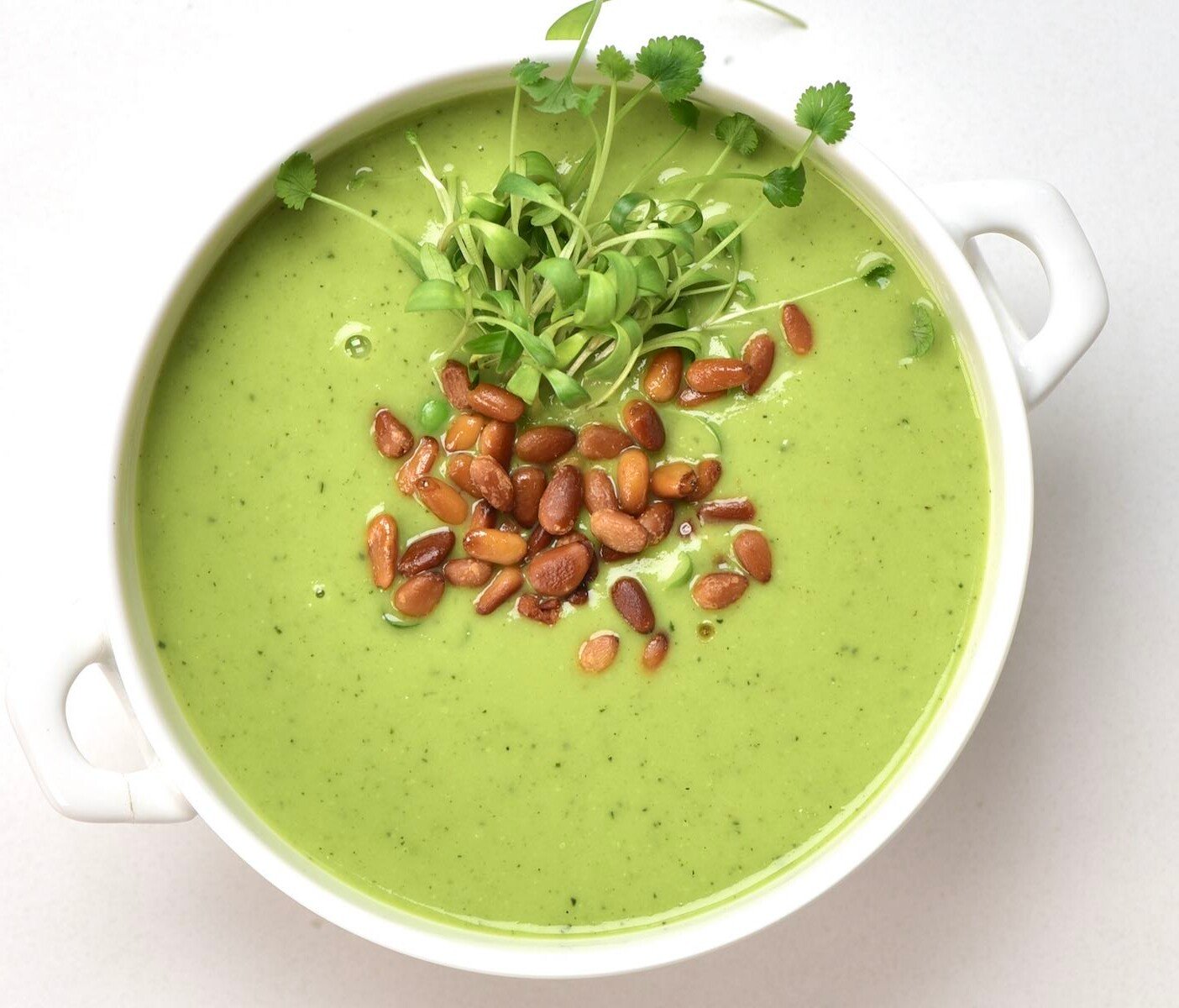
There is always time for a warming bowl of soup, and my latest obsession is this easy springtime soup. It’s a light but nutrient-dense green soup made with peas and zucchini. Its refreshing taste and healthful profile make it a great year-round option for a highly satisfying meal filled with plant-based protein and fiber. It’s easy to prepare, budget-friendly, and a great meal-prep/freezer-friendly soup, too.
It’s a great soup to add to your rotation, along with homemade tomato soup and homemade asparagus soup. And if you are looking for other recipes where the green peas shine, you might like this comforting pea stew.
Want to save this recipe?
Video tutorial
Ingredients
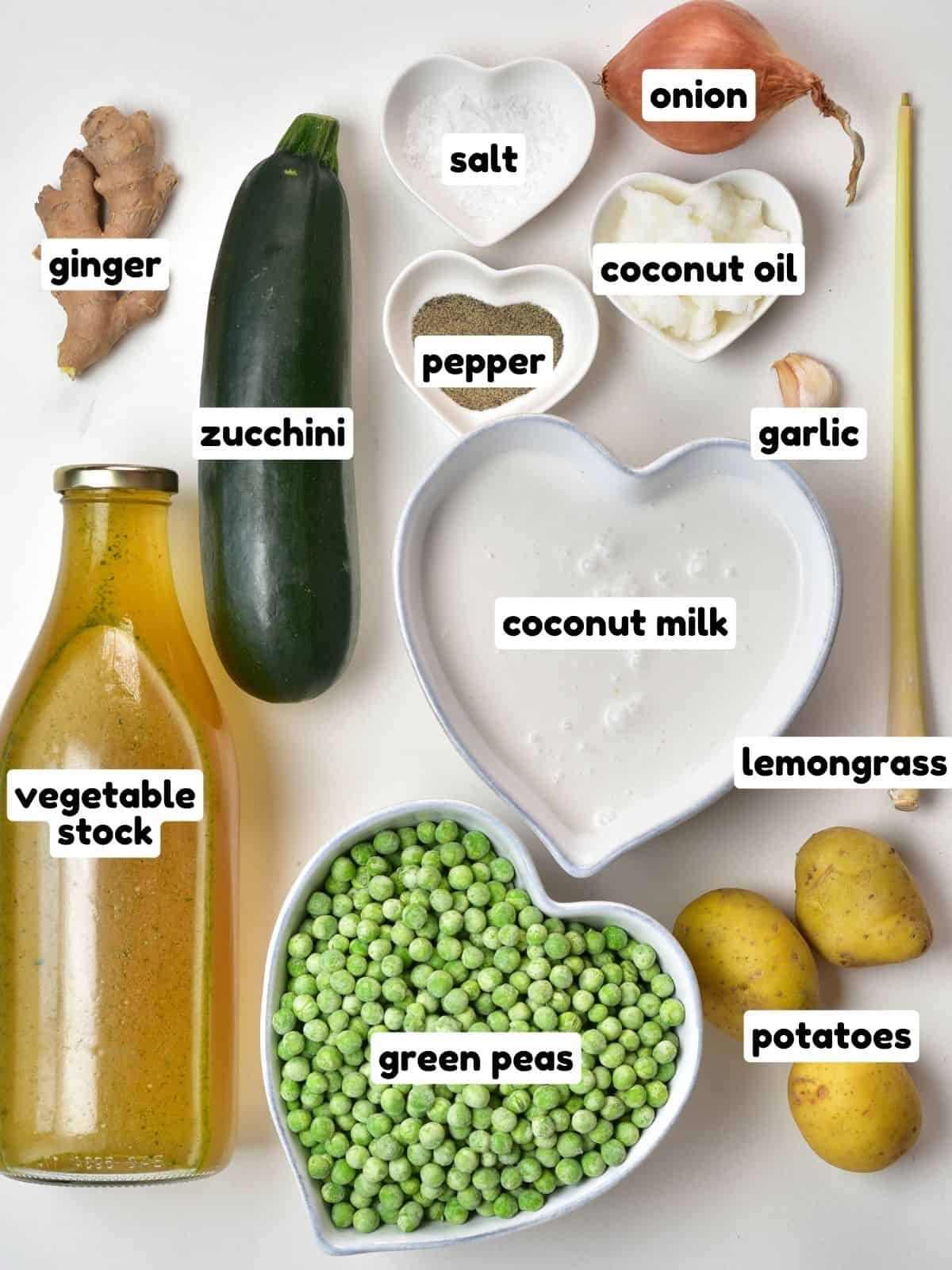
- Green peas: I love using frozen green peas as they are so convenient, but fresh green peas will work too.
- Vegetables: I add potatoes and zucchini to the frozen pea soup for extra flavor.
- Aromatics: Onion, ginger, and garlic.
- Vegetable stock: I often use homemade stock, but store-bought works just as well. Use a low-sodium option or adjust/omit the salt at the end.
- Full-fat coconut milk: For rich and creamy results. Alternatively, you can use light canned coconut milk.
- Coconut oil: or olive oil.
- Salt & pepper: to taste.
- Lemongrass: It’s completely optional but I love adding it for citrusy and bright flavor.
How to make green pea soup
Prepare the vegetables. Slice the zucchini, and dice the potato, onion, ginger, and garlic.
Saute the vegetables: Heat a large saucepan or Dutch oven over medium-high heat. Add the coconut oil and let it melt. Start by sautéeing the potatoes (3-5 minutes) as they take longer to cook. Once they are softened, add the onion, garlic, ginger, and lemongrass (if using) and sauté again for 1-2 minutes.
As soon as the onions have softened, add the zucchini, salt, and pepper and mix. Then add the peas and vegetable stock and bring to a boil. Lower the heat and allow it to simmer for about 10-15 minutes until the peas are fully thawed and warmed through. Finally, add the coconut milk. Simmer the soup for a further 1-2 minutes.
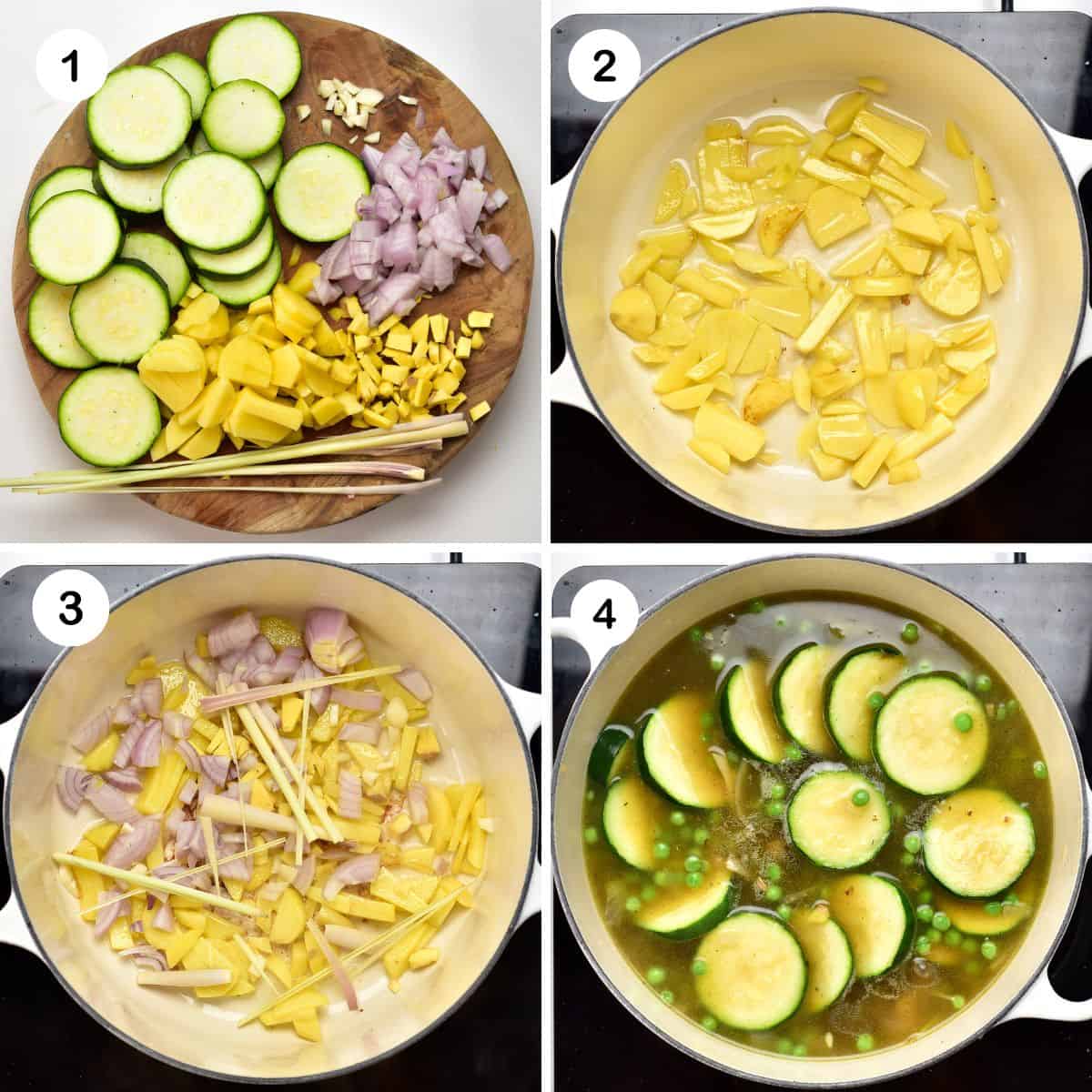
Blend the soup: Using a handheld immersion blender, blend the pea soup with frozen peas while on low heat. Keep mixing until you get a smooth consistency. Once you like the constancy, taste and adjust the seasoning if wanted.
Instead of using an immersion blender, you can blend the soup in a food processor/blender. You can also just the consistency – add more broth for a thinner soup.
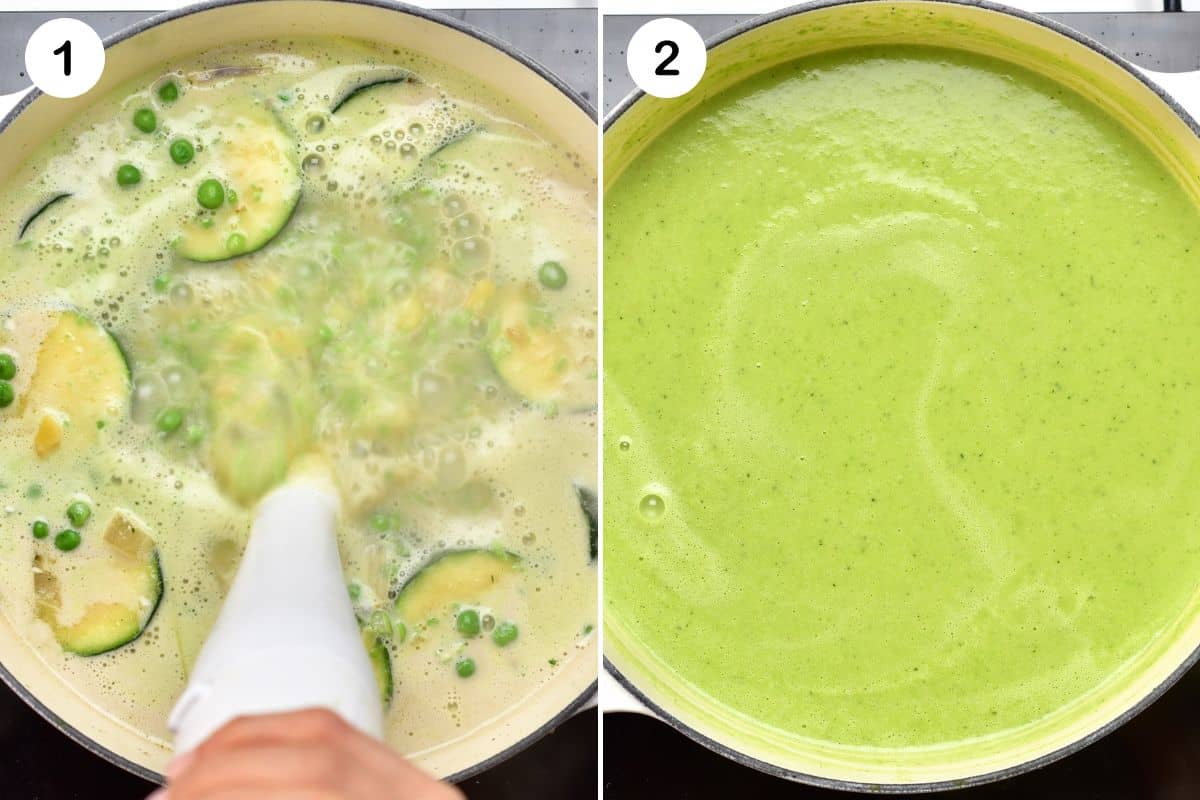
Serve: Finally, transfer to your bowls, garnish and serve immediately. You can top the pureed pea soup with some coriander, a few peas, or toasted pine nuts. Serve with toast or homemade seed crackers for extra crunch and enjoy your delicious soup.
How to store
In the fridge: After allowing any leftover soup to cool completely, transfer it to an airtight container and refrigerate. It will stay fresh for 4-5 days.
Freezer: For longer storage, freezing is an option. Transfer to reusable zip lock bags or freezer-safe containers, leaving headspace for expansion. It should keep well for at least two months.
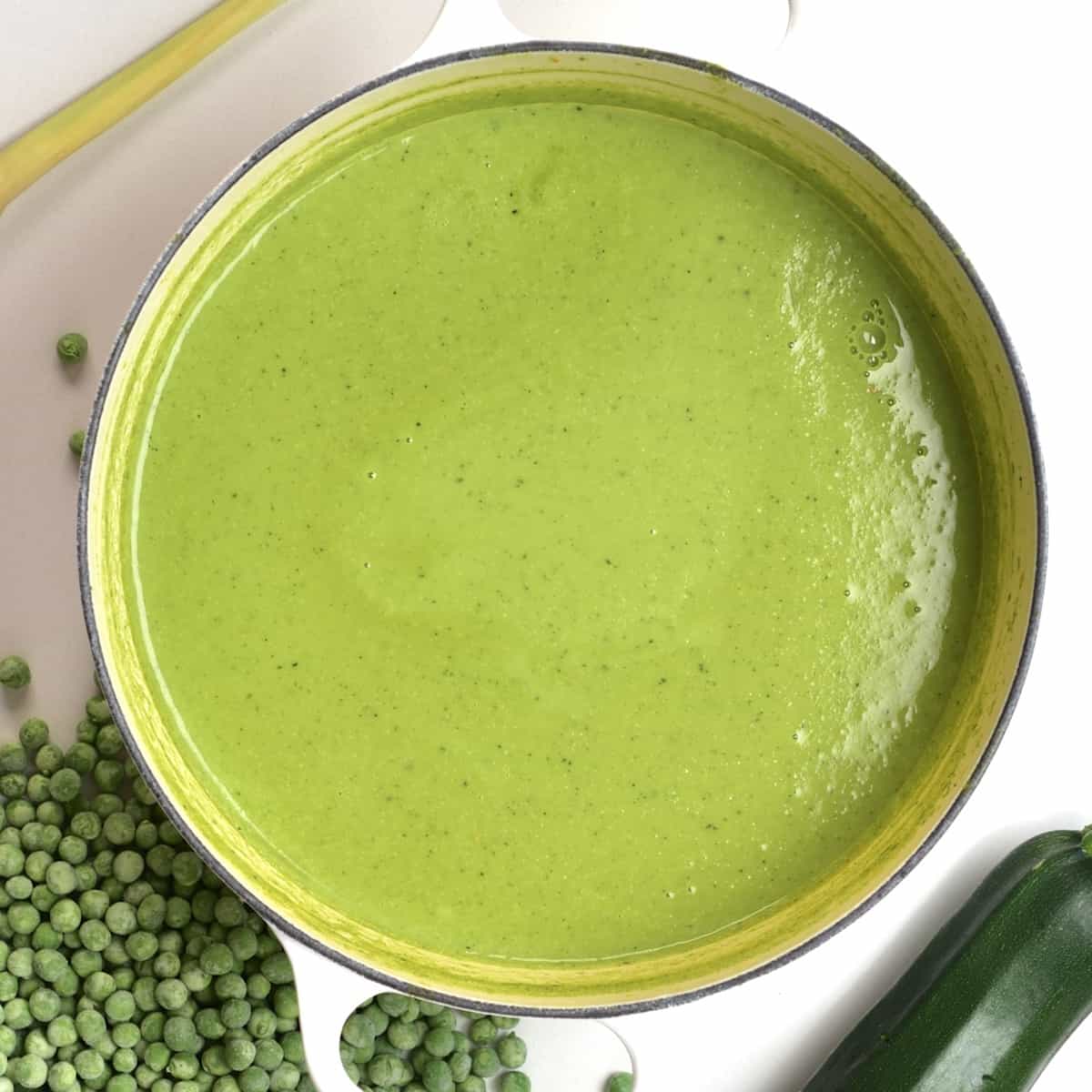
More creamy soup recipes
If you try this green pea soup recipe, let me know how it goes in the comments below. I’d appreciate a recipe card rating and would love to see your recipe recreations – tag me on Instagram @Alphafoodie!
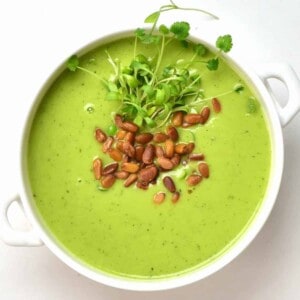
Green Pea Soup
Ingredients
- 18 oz green peas frozen or fresh
- 5.3 oz potatoes
- 2 zucchini
- 4 cups vegetable stock
- 1 ⅔ cup full fat coconut milk 1 x 14 oz can
- 2 Tbsp coconut oil
- 1 onion small
- 0.7 oz ginger
- 1 clove garlic
- 1/2 tsp salt
- 1/2 tsp black pepper
- 2 lemon grass stalk optional but adds lots of flavor
Instructions
- Slice the zucchini. Dice the potato, onion, ginger, and garlic.
- Heat a large saucepan or Dutch oven over medium-high heat. Add the coconut oil and let it melt. Add the potatoes and sauté them for 3-5 minutes.
- Once the potatoes are softened, add the onion, garlic, ginger, and lemongrass and sauté again for 1-2 minutes.
- Add the zucchini, salt, and pepper and mix.
- Add the peas and vegetable stock and bring to a boil. Lower the heat and allow it to simmer for about 10 minutes until the peas are fully thawed and warmed through.
- Add the coconut milk. Simmer the soup for a further 1-2 minutes.
- Using a handheld blender, blend the soup whilst on low heat. Keep mixing until smooth and creamy. Taste and adjust the seasoning if wanted.
- Transfer the green pea soup to bowls and garnish with your items of choice. I like to top it with some coriander, a few whole peas, toasted pine nuts, and some lime wedges.
Video
Notes
Nutrition
Nutrition information is automatically calculated, so should only be used as an approximation.




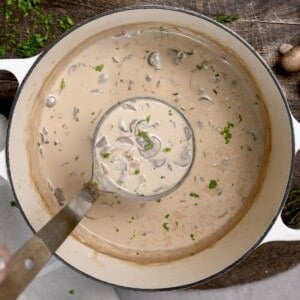
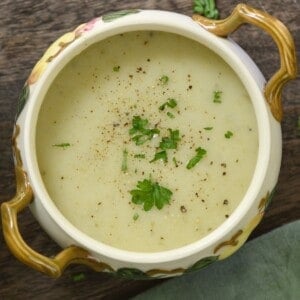










Hi Samira,
When you press the button to convert to metric in the recipe, the 18 oz green peas turn into 5 g of green peas!!
That wouldn’t be much of a pea soup 😉
Hi there,
Thank you so much for spotting this. Indeed, you need 500 grams (18 oz) of green peas for the recipe. It’s been updated. 🙂
Hi,
You said, “Keep mixing until you get a smooth constancy.” I’m pretty sure you meant consistency, right?
Other than that, the soup looks great. Because I’m being vigilant about not incorporating oil into my cooking, I would saute the the onion, garlic, ginger and lemongrass with a little water (it works, really!) then add the zucchini, saute a little longer, adding a bit of water if anything begins to stick to the pot. Finally, add potatoes to the pot after adding the vegetable stock so they’ll soften by boiling, adding the peas last so they maintain their color and fresh taste.
Finally, I would use light coconut milk rather than the full-fat type.
Hi Dan,
Thank you for pointing that out, I have corrected it. And thank you for your feedback. 🙂
The first instruction is to slice the aubergine (eggplant.). Did you mean zucchini?
Sorry about that, Pat. You are right – it’s slice the zucchini. Updated 🙂